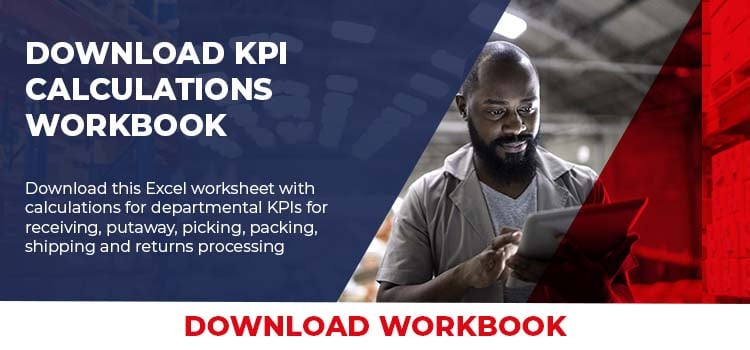An observation that famed British physicist, Lord Kelvin, made about scientific experimentation and operational improvements over 100 years ago is still relevant today in the fulfillment industry. “If you cannot measure it, you cannot improve it.”
experimentation and operational improvements over 100 years ago is still relevant today in the fulfillment industry. “If you cannot measure it, you cannot improve it.”
As warehouse consultants, we are constantly seeking to improve e-commerce and retail operations to be more efficient and to improve their profitability and customer service.
In order to improve operations, we first need to measure and track key metrics. Examples of key metrics are the total warehouse cost per order and order turnaround time. Once we understand what these metrics show, we can then develop options for processes that reduce steps and therefore cost; or improve service levels in the warehouse such as the order turnaround time measured in hours.
What key operational performance metrics do you monitor and use to improve processes? Here are the metrics which we recommend as the starting point in the measurement and improvement process:
Warehouse Cost per Order
This calculation is the total warehouse costs for all warehouse functions divided by the number of orders processed for the measured time frame. The measured time frames or reporting periods start out as annual (or trailing 12 months) and then move to more frequent (such as monthly or quarterly).
The typical costs that are gathered when calculating warehouse cost per order, for the measured time frame, include the following:
- Labor costs associated with fulfillment - such as receiving/inbound, putaway and replenishment, picking, packing, and shipping, and returns management.
- Managers and supervisors labor costs that are directly associated with the operations. This would include clerical, as well as those in transportation and inventory control, along with janitorial and security etc.
- Facility costs including the lease and TICAM (taxes, insurances and common area maintenance). Also include depreciation and amortization for conveyance, sortation, WMS and any other automated systems you may have.
- Packing and shipping supplies - pallets, corrugate cartons, packaging tape, strapping, all void fills and pallet wrap etc.
These warehouse costs should be available from your company’s profit & loss statement, and they comprise a high percentage of all fulfillment expenses. The number of orders should come from your warehouse management system, or WMS.
Our recommendation is that if you intend to benchmark against other companies, its important to measure the total warehouse costs per order two ways.
- The first is to calculate warehouse cost per order excluding employee benefits.
- The second calculation of warehouse cost per order includes employee benefits.
Benefits can vary widely between operations so when benchmarking, the first calculation above is best to use. Benefits are also not something an operations executive has direct control over generally. However, they may add 15% to 30% to the total warehouse cost per order.
Another expense that is not included in the cost per order calculation is outbound and inbound shipping costs. Shipping costs are the single largest costs involved in order fulfillment. They can be larger than the sum of all warehouse costs together as defined above. Outbound shipping varies based on company volumes shipped and shipping cost negotiation, which is why they distort comparisons you make to other e-commerce fulfillment operations.
Using the total cost per order you can now drive the calculation to a more granular level:
Read “How Do You Calculate Fulfillment Cost Per Order?”
Cost per Carton Shipped
Cost per carton shipped is derived by dividing the total warehouse cost by the number of cartons shipped. The number of cartons shipped may be 10% to 20% higher than the number of orders because all items cannot always be combined into one carton.
Cost per Order Line Processed
Cost per order line processed can be found by dividing the total warehouse cost by the number of order lines. The majority of consumer e-commerce orders are 3 order lines (and units) or less. B2B or retail will have much larger orders.
Cost per Unit Shipped
Cost per unit shipped is found by dividing the warehouse cost by the number of units. As you develop these comparisons, it is helpful to calculate costs for larger B2B or retail orders versus smaller direct to customer orders.
Labor Cost per Order
In most e-commerce companies, labor is more than 50% of the total warehouse cost per order when you exclude benefits and shipping costs. In terms of giving a metric to supervisors to manage and monitor, the labor cost for your operation is the one they can influence and reduce.
Fulfillment Costs as a Percent of Net Sales
CFOs are interested in the fulfillment expense as a percent to net sales. This is calculated by dividing the total warehousing cost by the net sales, and then multiplying by 100 to determine the percentage. This ratio can be misleading because e-commerce average orders can vary widely and may be misleading when comparing two businesses.
Characteristically, e-commerce fulfillment is largely manual in terms of processes until warehouse automation can be justified. In largely manual operations, order volume and size of the company doesn’t always translate to efficiency on a cost per order basis. The key to getting more acceptable fulfillment cost still depends on how effective your managers and supervisors are.
Expand Measurement to Departments and Functions
Don’t try to develop too many metrics at once. Sometimes businesses have dozens of metrics, but they are meaningless and cumbersome to keep collecting and reporting. Pick a select few to focus on initially and potentially add more overtime if they have merit.
Other important metrics include returns-based measurements such as cost per return, cost per returned unit and returns as a percent to gross demand (orders) of dollars; fulfillment service levels such as dock to stock turnaround time, order fulfillment turnaround time, returns processing time, and percent of orders shipped same day.
Picking and packing are important because together they often are more than 50% of the labor expenses. Costs for picking, such as cost to pick per order -- per line and per unit -- and packing, such as cost to pack an order or shipment, should be measured.
Data Accuracy and Timeliness
Many order management systems and ERPs used in e-commerce fulfillment were not designed to collect the basic fulfillment data. They may be strong in many other functions but weak on the warehouse data side. Warehouse management systems, or WMS, are designed specifically for fulfillment and warehousing. They are designed to collect this type data and have the ability to report on these metrics. Investigate closely how the data available to you is collected and determine its accuracy and timeliness.
Also, when you decide to collect and report at a lower level of detail, such as by department, you will need to determine how you’re going to collect the data and determine its accuracy. For example, as companies do more cross training and use employees across two or more departments – e.g., receiving and returns – collecting the number of transactions and hours worked may not be available without a labor management system, or LMS, set up to collect departmental data.
How does your e-commerce fulfillment operation stack up? Remember to define the data that represents a unit of work and a good process measurement. Work with your employees on how to collect the data properly and on a timely basis. Some data will be operational and other data can be derived from financial systems. Determine how timely and accurate the results will need be. What do these statistics tell you about your business? Hopefully they show you where you should improve your operation or where to focus your efforts.






SHARE